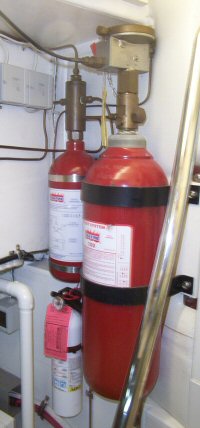
We had our local fire extinguisher technician in the other day to tag some fire extinguishers. He made the comment that the half million dollar boat that had these extinguishers was being protected by a $40 piece of equipment. That hit home! Most of the boats we have in here have cheap fire extinguishers and most do not have fire suppression systems in the engine room. This is the value they have put on their boat and maybe even the price they have put on their own safety.
Bear in mind that a small canister of foam or dry chemical isn’t adequate to extinguish a major fire, particularly in the engine room. This is what we usually see – a couple of 5 lb. extinguishers stowed away in a locker somewhere. If you are not on board, a guest may have a hard time finding even these most inadequate safety devices.
Extinguishers that are effective on one kind of burning material don’t necessarily work well on another. To indicate the kinds of fire for which an extinguisher is suitable, it will usually be labeled with an Underwriters Laboratory (UL) rating using the code letters A, B, C, or D.
- Class A -Burning wood, paper, cloth, and other everyday materials. Enough water can extinguish such fires.
- Class B -Burning liquids, such as kitchen grease, gasoline, oil, and other flammable liquids. Putting water on such fires may simply spread them.
- Class C -Fires involving electrical equipment. Spraying such a fire with water might not be a good idea.
Since Class A fires can be extinguished with water, most boats I see have BC extinguishers. But since one would only have access to the quantity of water required to fight a fire at dockside, it would behoove you to have ABC extinguishers instead.
Auto-suppression systems
The best move for protection of your vessel is to install an auto-suppression system in the engine room. The way this works is to interrupt the chemical reaction of the fire without
displacing oxygen. This has both advantages and disadvantages. It means that halon is less dangerous to us in enclosed spaces than, say, CO 2, which can snuff out a person as quickly as a fire in an enclosed space. But the downside is that it won’t starve the engine into shutting down. But you can install an automatic shut-down on the engine as a recommended addition.
The most recognized system is the Halon system, which has now been taken off the market due to the chlorofluorocarbons in the Halon that have been proven to destroy ozone. The newer models are less effective than the Halon, so bigger canisters are needed to offer the same degree of protection.
The size of system you should install is determined by the square footage of your engine room. Once again, don’t be afraid to oversize a bit. Most people make a guess as to the square footage and tend to guess on the light side to save a few bucks.
Which to choose
I had a talk this morning with our local technician while discussing a client’s request for a 10 lb CO2 extinguisher for his galley. This guy is savvy, but neither he or I knew the size of that particular unit. It was huge – too big for the galley. According to the technician, a 6lb Halon canister is about the same size as a small ABC extinguisher and is just as or more effective than the CO2. Both work on the same principal of extinguishing by removing the oxygen. Plus the halon is the cleanest (and most expensive) – that is why it is used in computer labs.
The bottom line
Why spend thousands of dollars on a piece of electronics you may or not need, but skimp on the safety of your boat. Get familiar with your protection, show guests where the extinguishers are kept and keep up to date on the inspections.
 We had our local fire extinguisher technician in the other day to tag some fire extinguishers. He made the comment that the half million dollar boat that had these extinguishers was being protected by a $40 piece of equipment. That hit home! Most of the boats we have in here have cheap fire extinguishers and most do not have fire suppression systems in the engine room. This is the value they have put on their boat and maybe even the price they have put on their own safety.
Bear in mind that a small canister of foam or dry chemical isn’t adequate to extinguish a major fire, particularly in the engine room. This is what we usually see – a couple of 5 lb. extinguishers stowed away in a locker somewhere. If you are not on board, a guest may have a hard time finding even these most inadequate safety devices.
Extinguishers that are effective on one kind of burning material don’t necessarily work well on another. To indicate the kinds of fire for which an extinguisher is suitable, it will usually be labeled with an Underwriters Laboratory (UL) rating using the code letters A, B, C, or D.
We had our local fire extinguisher technician in the other day to tag some fire extinguishers. He made the comment that the half million dollar boat that had these extinguishers was being protected by a $40 piece of equipment. That hit home! Most of the boats we have in here have cheap fire extinguishers and most do not have fire suppression systems in the engine room. This is the value they have put on their boat and maybe even the price they have put on their own safety.
Bear in mind that a small canister of foam or dry chemical isn’t adequate to extinguish a major fire, particularly in the engine room. This is what we usually see – a couple of 5 lb. extinguishers stowed away in a locker somewhere. If you are not on board, a guest may have a hard time finding even these most inadequate safety devices.
Extinguishers that are effective on one kind of burning material don’t necessarily work well on another. To indicate the kinds of fire for which an extinguisher is suitable, it will usually be labeled with an Underwriters Laboratory (UL) rating using the code letters A, B, C, or D.
 The best move for protection of your vessel is to install an auto-suppression system in the engine room. The way this works is to interrupt the chemical reaction of the fire without
displacing oxygen. This has both advantages and disadvantages. It means that halon is less dangerous to us in enclosed spaces than, say, CO 2, which can snuff out a person as quickly as a fire in an enclosed space. But the downside is that it won’t starve the engine into shutting down. But you can install an automatic shut-down on the engine as a recommended addition.
The most recognized system is the Halon system, which has now been taken off the market due to the chlorofluorocarbons in the Halon that have been proven to destroy ozone. The newer models are less effective than the Halon, so bigger canisters are needed to offer the same degree of protection.
The size of system you should install is determined by the square footage of your engine room. Once again, don’t be afraid to oversize a bit. Most people make a guess as to the square footage and tend to guess on the light side to save a few bucks.
Which to choose
I had a talk this morning with our local technician while discussing a client’s request for a 10 lb CO2 extinguisher for his galley. This guy is savvy, but neither he or I knew the size of that particular unit. It was huge – too big for the galley. According to the technician, a 6lb Halon canister is about the same size as a small ABC extinguisher and is just as or more effective than the CO2. Both work on the same principal of extinguishing by removing the oxygen. Plus the halon is the cleanest (and most expensive) – that is why it is used in computer labs.
The bottom line
Why spend thousands of dollars on a piece of electronics you may or not need, but skimp on the safety of your boat. Get familiar with your protection, show guests where the extinguishers are kept and keep up to date on the inspections.
The best move for protection of your vessel is to install an auto-suppression system in the engine room. The way this works is to interrupt the chemical reaction of the fire without
displacing oxygen. This has both advantages and disadvantages. It means that halon is less dangerous to us in enclosed spaces than, say, CO 2, which can snuff out a person as quickly as a fire in an enclosed space. But the downside is that it won’t starve the engine into shutting down. But you can install an automatic shut-down on the engine as a recommended addition.
The most recognized system is the Halon system, which has now been taken off the market due to the chlorofluorocarbons in the Halon that have been proven to destroy ozone. The newer models are less effective than the Halon, so bigger canisters are needed to offer the same degree of protection.
The size of system you should install is determined by the square footage of your engine room. Once again, don’t be afraid to oversize a bit. Most people make a guess as to the square footage and tend to guess on the light side to save a few bucks.
Which to choose
I had a talk this morning with our local technician while discussing a client’s request for a 10 lb CO2 extinguisher for his galley. This guy is savvy, but neither he or I knew the size of that particular unit. It was huge – too big for the galley. According to the technician, a 6lb Halon canister is about the same size as a small ABC extinguisher and is just as or more effective than the CO2. Both work on the same principal of extinguishing by removing the oxygen. Plus the halon is the cleanest (and most expensive) – that is why it is used in computer labs.
The bottom line
Why spend thousands of dollars on a piece of electronics you may or not need, but skimp on the safety of your boat. Get familiar with your protection, show guests where the extinguishers are kept and keep up to date on the inspections. 
